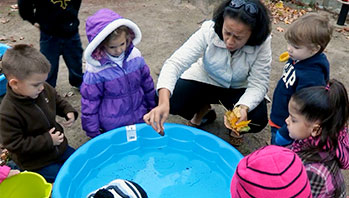- camera
- clipboard
- magnifying lenses
- paper
- pen
- flower
- leaf
- plant
- stem
MA Standards
Language/L.PK.MA.6: Use words and phrases acquired through conversations, listening to books read aloud, activities, and play.
MA Draft STE Standards:
Life Sciences/From Molecules to Organisms: Inheritance and Variation of Traits/LS1/3.A: Describe/draw and compare the body parts of animals (including themselves) and plants they are investigating [System] and explain functions of some of the observable body parts. [Structure and Function]
Life Sciences/From Molecules to Organisms: Inheritance and Variation of Traits/LS1/3.C: Use their sense in their exploration and play to gather information. [Structure and Function]
Head Start Outcomes
Logic and Reasoning/Reasoning and Problem Solving: Classifies, compares, and contrasts objects, events, and experiences.
Science Knowledge/Scientific Skills and Method: Observes and discusses common properties, differences, and comparisons among objects.
Science Knowledge/Scientific Skills and Method: Collects, describes, and records information through discussions, drawings, maps, and charts.
PreK Learning Guidelines:
English Language Arts/Language 2: Participate actively in discussions, listen to the ideas of others, and ask and answer relevant questions.
Science and Technology/Inquiry Skills 4: Record observations and share ideas through simple forms of representation such as drawings.
Science and Technology/Life Sciences 10: Observe and identify the characteristics and needs of living things: humans, animals, and plants.
Explore Together (outdoors): Flowers and Vegetables

© Commonwealth of Massachusetts, Department of Early Education and Care. All rights reserved.
STEM Key Concepts: Many foods that animals, including humans, eat come from plants; We eat certain leaves, roots, fruits, and seeds; Plants exhibit diversity and variation
ELA Focus Skills: Compare and Contrast, Follow Directions, Listening and Speaking, Vocabulary
Educator Prep: Be sure to check the area you will bring children to before going outdoors. Choose an area where all plants are safe for children to touch and smell.
Safety Tips:
- Remind children to wash their hands before and after the activity.
- Children’s dietary and allergy needs have to be taken into account before introducing them to any food items.
- Be aware of and check for poison ivy, poison sumac, thorny or prickly bushes before gathering children in a designated area.
- Remind children not to eat ANY plants or touch any plants without asking an adult.
Take children outside to explore flowering plants. Have children smell and touch the plants. Encourage them to use their magnifying glasses to examine plant parts. Prompt children to:
- Compare the flowering plant parts to the food plants they have been exploring
- Compare the flowers to broccoli and cauliflower flowers (have those plants on hand)
- Explore the soil; compare it to the soil in their pots
- Explore plants on the ground in the area; compare them to plants on the ground in other places they have explored
- Notice any bulbs or seeds
Give children drawing materials and allow them to use a camera or cell phone to take pictures to record their observations. Encourage them to draw the flowers in detail as best they can—recording the number of leaves, the colors, and the parts of the flowers. Talk about the number of petals and ask children to identify other flower parts they see (stems, leaves, blossoms).
Reflect and Share
Have children share their drawings of the flowers. After children have shared their observations, explain that there are some flower plants that people eat, too. Revisit the discussion about how people all over the world have different customs about what they eat: they eat different plants, different parts of plants, and prepare them in different ways to eat.
